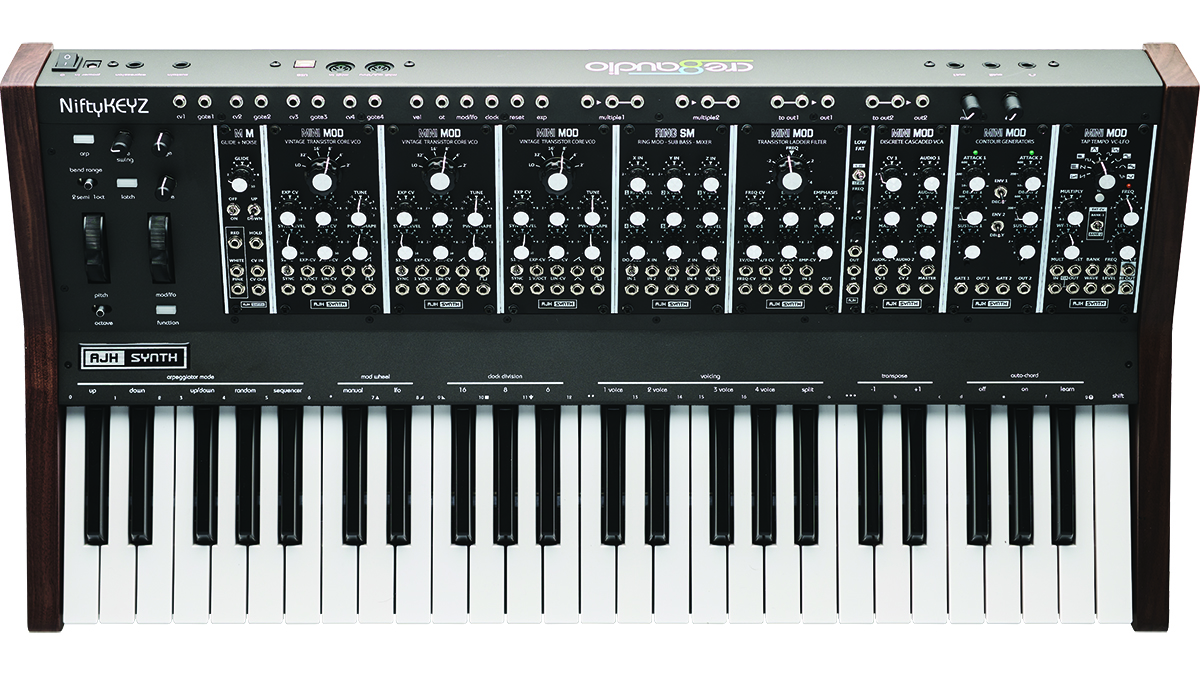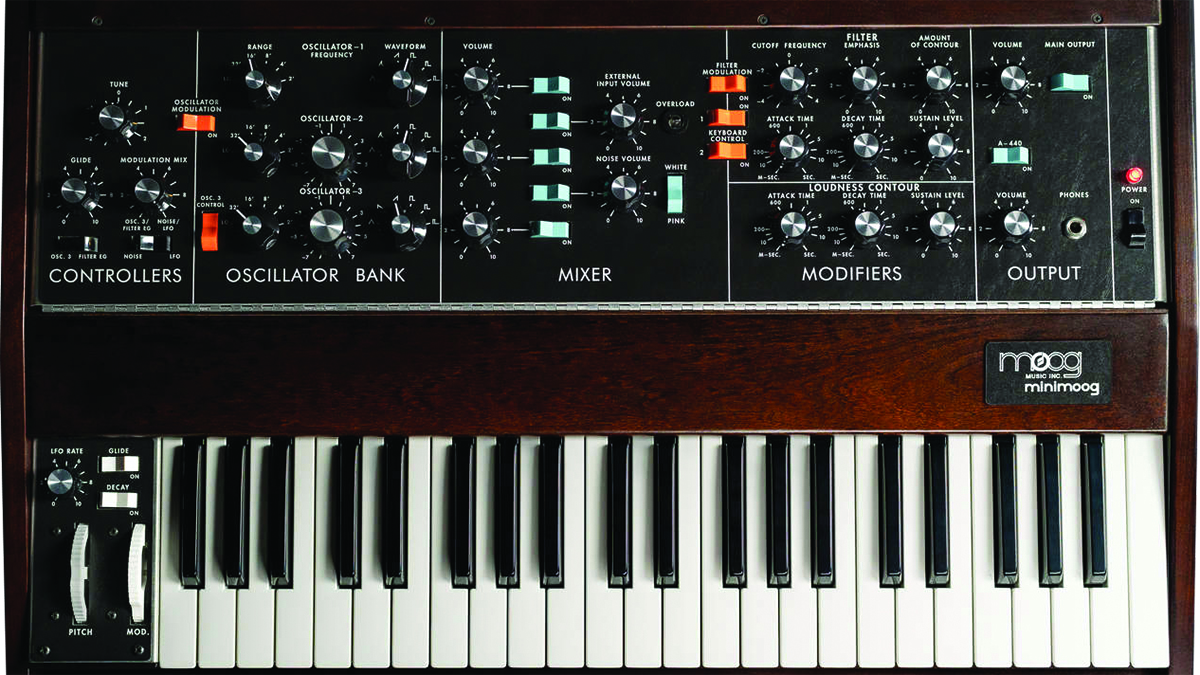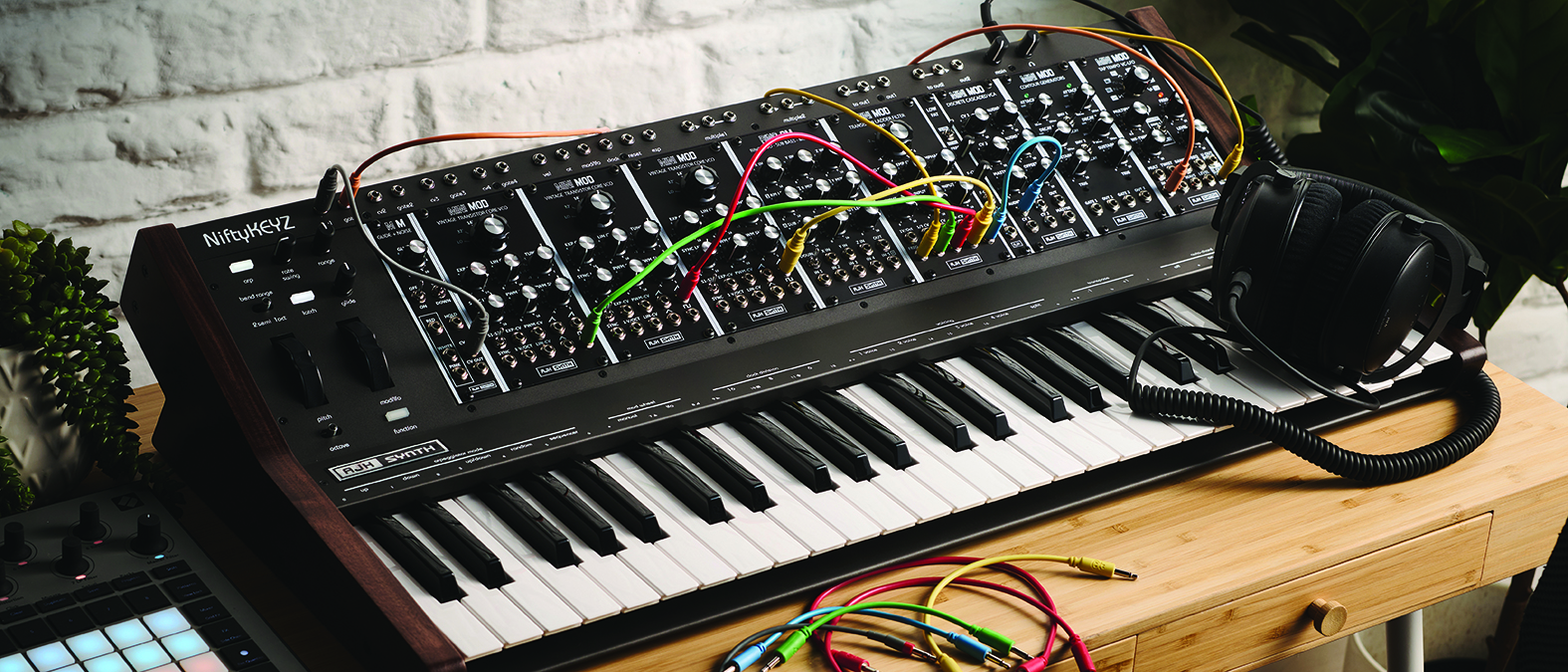MusicRadar Verdict
As a faithful reincarnation of the Minimoog, this system is extraordinary! All of the charm of the original, with enormous extra capability.
Pros
- +
It’s a fully-formed Minimoog, in Eurorack form.
- +
Huge number of additional features, not available on the original Mini.
- +
Intuitive keyboard construct, allowing totally immersive playing and control.
Cons
- -
It’s a Eurorack system at heart, and, unlike an original Minimoog, it requires some patching.
MusicRadar's got your back
AJH Synth MiniMod Keyz: What is it?
If you’re reviewing something this indebted to history, it’s worth starting at the beginning. In the Minimoog, Dr Bob Moog distilled the voltage controlled modular musings of the ’60s down to a convenient monophonic synth, which changed music forever.
The appetite for the sound of the Minimoog has never really diminished, except for a slight lull in the late ’80s and early ’90s, when analogue fell out of favour. This makes the Mini’s return in modular form all the more timely.
So what are we looking at with this new release? It’s really two components which have been amalgamated to create an almighty solution. Let’s deal with the modules and sound first; AJH Synth created the original MiniMod system some years ago, as a literal facsimile of the original Minimoog in Eurorack form, employing seven modules to recreate the signal path. As the years have rolled by, the AJH Mini-brief has broadened, with further modules joining the AJH lineup. Many of these draw upon inspiration from synth design past masters, while others simply add further scope to the existing modules.

AJH Synth MiniMod Keyz: Performance and verdict
The beating heart of the MiniMod Keyz flows from three AJH transistor VCOs and a classic 24dB ladder filter. Each of the VCOs are identical, allowing the connection of wave output from each, to one of three inputs on the filter module. Each input offers its own input level, so you can meld your waves together, in the exact same way that you would on a Minimoog. The filter then feeds the VCA stage; this is where things get interesting, as both the filter and amplifier sections are open to overdrive, replicating the old Minimoog trick of running the headphone jack back into the synth’s external input connection.
Gating is controlled via two 3-way envelopes (contour generators), which mirror the original Moog design to perfection. Gating can be shared, while the envelopes can be independently split, with one controlling the amplifier, and the other controlling filter cutoff. Worth remembering, though, that this is a Eurorack system, so anytime you want to effect a signal path or create a modulation, you’ll need to patch in another cable.
At the very front of the CV control lineup, is one of the smallest but most ubiquitous of the MiniMod originals. The Glide + Noise module provides access to portamento and noise. Not only does the glide perfectly mimic an original Mini, but it’s been enhanced via the deployment of a switch, to induce portamento in either upward or downward only directions, along with the more usual glide-both-ways.

• Moog Minimoog Model D (2022 reissue)
The latest reissue of the original classic provides some very helpful upgrades, including MIDI, additional LFO and a pitch wheel that centres, unlike the original. It’s a total classic, but at a classic price.
• Studio Electronics MIDIMini V30
Another reissue, but this time from the innovators that created the rack-mounted Midimoog, 30 years ago. Packed full of useful features and signal enhancements, it’s another premium product, that packs one hell of a punch.
Gating is controlled via two 3-way envelopes (contour generators), which mirror the original Moog design to perfection. Gating can be shared, while the envelopes can be independently split, with one controlling the amplifier, and the other controlling filter cutoff. Worth remembering, though, that this is a Eurorack system, so anytime you want to effect a signal path or create a modulation, you’ll need to patch in another cable.
Want all the hottest music and gear news, reviews, deals, features and more, direct to your inbox? Sign up here.
At the very front of the CV control lineup, is one of the smallest but most ubiquitous of the MiniMod originals. The Glide + Noise module provides access to portamento and noise. Not only does the glide perfectly mimic an original Mini, but it’s been enhanced via the deployment of a switch, to induce portamento in either upward or downward only directions, along with the more usual glide-both-ways.
The sublime sound and sheer grunt that can be generated from the MiniMod system has always been applauded for accuracy and detail, but AJH has extended the criteria here. The addition of the Ring SM module, which is a multipurpose device that includes a ring modulator, sub bass generator and 5-channel mixer, is a fine example. The ring mod component is based upon the EMS VCS3 design, being one of the most highly prized ring mod circuits in existence. The gritty and gnarly output provides a colour which the original Mini was not able to embrace, while the sub bass generator can track an oscillator, producing a sine waveform at either one or two octaves below the inputted signal. As if three oscillators isn’t enough, this adds a sub to your sub, that’ll have the ground shaking in a millisecond!
If all that bottom end is too much, the slim-line Low Fat filter module is another new module to the system. In essence, it’s a high pass filter, operating at either 6dB or 12dB slopes. It’s very colourful, while being very helpful should things get out of hand in the cone-shaking department.
Finally, the Tap Tempo LFO module provides an easy-access method for adding LFO, without the need to steal one of your main oscillators, which was always the case with the original Mini. Moreover, it’s stacked full of complex waveforms, which can be placed under clock control, or used as clock masters.
The framework for the MiniMod is the NiftyKeyz controller keyboard, which is supplied by Cre8audio. This is a master stroke; placing one of the most highly regarded Eurorack systems into a single unit creates instant musical access to the system, arguably what the original Minimoog was all about. However, it’s only part of the solution, as the NiftyKeyz controller offers several party tricks. The keybed is a good quality 4-octave design, with a number of lovely inclusions, like velocity and aftertouch control over CV, a basic step sequencer and arpeggiator. It also provides clocking capabilities, with a further onboard LFO and CV/note splitting, meaning it can easily be configured to provide polyphony, although in this case it can only provide three voices, mirroring the included number of AJH oscillators. There’s simple connectivity, for both audio output and MIDI, making it easy to link to existing DAWs.
The front and rear AJH nameplates look resplendent against American walnut end-cheeks, completing the look beautifully. More generally, the build quality of the AJH modules is weapons grade and second to none – if only all Eurorack modules were built this well! As a contender to the Minimoog, it’s an all-in-one solution that extends the sonic palette of the original by some margin, providing a highly versatile system that could become the backbone of a Eurorack system, or the centrepiece of a studio setup.
MusicRadar verdict: As a faithful reincarnation of the Minimoog, this system is extraordinary! All of the charm of the original, with enormous extra capability.
AJH Synth MiniMod Keyz: The web says
"Since the 1970s, players have dreamed of a modular Minimoog with extended voicing and performance capabilities. Within the limits of emulative technology, that’s what we have here."
Sound On Sound
AJH Synth MiniMod Keyz: Hands-on demos
AJH Synth Official
AJH Synth MiniMod Keyz: Specifications
- KEY FEATURES I/O: Eurorack mini-jack CV/Gate connectivity throughout, with minijack and 1/4” audio output. MIDI over USB or traditional 5-pin connectors.
- DIMENSIONS: 710 x 370 x 140mm.
- WEIGHT: 11kg.
- CONTACT: AJH Synth
